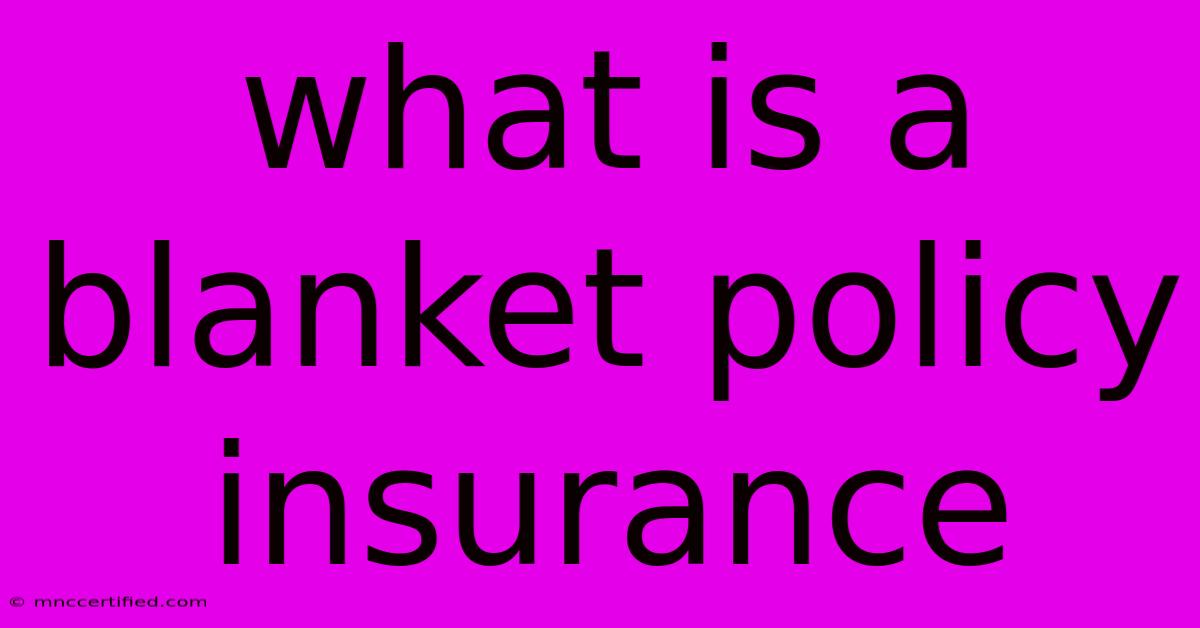What Is A Blanket Policy Insurance

Table of Contents
What is a Blanket Policy Insurance? A Comprehensive Guide
Blanket insurance policies offer a streamlined approach to risk management, covering a wider range of assets or liabilities under a single policy. Unlike specific insurance policies that individually cover each item, a blanket policy provides comprehensive protection with a single premium and simplified administration. This guide explores the intricacies of blanket insurance, its benefits, limitations, and various applications across different industries.
Understanding Blanket Policy Insurance: A Simplified Explanation
A blanket insurance policy offers coverage for a group of similar items or a defined category of risks, rather than insuring each individual item separately. This approach significantly reduces administrative burden and simplifies the claims process. Imagine insuring multiple pieces of equipment; instead of individual policies for each piece, a blanket policy covers the entire lot up to a specified limit. This principle applies across various insurance types, including property, liability, and even crime insurance.
Key Characteristics of Blanket Policies:
- Broad Coverage: Covers a group of items or risks under a single policy.
- Simplified Administration: Reduces paperwork and simplifies claims processing.
- Cost-Effective: Potentially lower overall premiums compared to numerous individual policies.
- Single Premium: A consolidated premium covers all items or risks included in the policy.
- Aggregate Limit: A maximum payout limit applies to the entire covered group, not each individual item.
Types of Blanket Insurance Policies:
Blanket insurance policies are versatile and can be tailored to meet specific needs. Here are some common types:
-
Blanket Property Insurance: Protects multiple properties or items within a single location or across various locations. This could include buildings, equipment, inventory, or other assets. This is a frequently used type of blanket policy, popular with businesses operating across multiple sites.
-
Blanket Liability Insurance: Provides coverage for various potential liabilities, such as bodily injury or property damage caused by your business operations. This can be crucial for businesses with diverse operations or numerous employees.
-
Blanket Crime Insurance: Covers losses resulting from criminal activities like theft, robbery, or employee dishonesty across multiple locations or departments within a company. This type of policy is critical for companies concerned about internal and external theft risks.
-
Blanket Bonds: These provide surety coverage for numerous employees or projects simultaneously.
Benefits of Choosing a Blanket Insurance Policy:
- Reduced Administrative Costs: Less paperwork, fewer policy renewals to manage, leading to significant cost savings.
- Streamlined Claims Process: Simplified documentation and faster claim settlements.
- Improved Risk Management: Comprehensive coverage offers peace of mind, protecting against various potential losses.
- Potentially Lower Premiums: While this isn't always guaranteed, the aggregated risk assessment can often result in lower premiums compared to individual policies.
- Enhanced Coverage: Provides wider coverage than individual policies, potentially covering unforeseen risks.
Limitations of Blanket Insurance Policies:
- Aggregate Limits: The total payout is capped by the aggregate limit, regardless of the number of losses.
- Complexity: While simpler than multiple policies, understanding the policy's terms and conditions is crucial.
- Suitability: Not all businesses or risks are suited to blanket policies. Specific assets or high-value items might require separate coverage.
Is a Blanket Policy Right for You?
Choosing the right insurance policy is crucial. Whether a blanket policy is suitable depends on your specific circumstances and risk profile. Factors to consider include:
- Number of assets or liabilities: A large number of similar assets suggests a blanket policy might be beneficial.
- Type of assets: The nature of your assets and the risks they face are crucial in determining suitability.
- Budget: Compare the cost of a blanket policy against individual policies to determine cost-effectiveness.
- Complexity of operations: If your business operates across multiple locations or has complex risk profiles, a blanket policy could streamline your risk management strategy.
Consider consulting with an insurance professional to determine the best approach for your unique needs. They can help assess your risks and recommend the most appropriate and cost-effective insurance solution. They can also help you understand the intricacies of policy wording and ensure you're adequately protected.
Keywords: blanket insurance, blanket policy, insurance policy, property insurance, liability insurance, crime insurance, blanket bond, risk management, insurance coverage, comprehensive insurance, cost-effective insurance, simplified insurance, aggregate limit.

Thank you for visiting our website wich cover about What Is A Blanket Policy Insurance. We hope the information provided has been useful to you. Feel free to contact us if you have any questions or need further assistance. See you next time and dont miss to bookmark.
Featured Posts
-
Very Old Barton Bottled In Bond
Nov 23, 2024
-
Government Bonds Crossword Clue
Nov 23, 2024
-
Bayern Vs Augsburg Live Stream Game Details
Nov 23, 2024
-
Live Leicester City Chelsea Highlights
Nov 23, 2024
-
Investment Options Crossword Clue
Nov 23, 2024